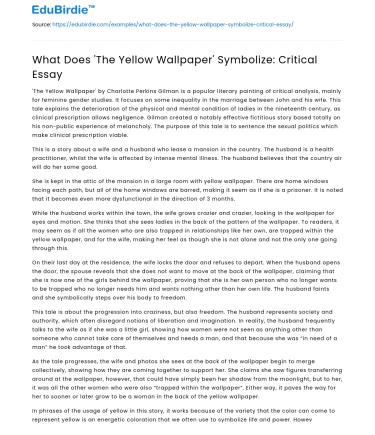'The Yellow Wallpaper' by Charlotte Perkins Gilman is a popular literary painting of critical analysis, mainly for feminine gender studies. It focuses on some inequality in the marriage between John and his wife. This tale explains the deterioration of the physical and mental condition of ladies in the nineteenth century, as clinical prescription allows negligence. Gilman created a notably effective fictitious story based totally on his non-public experience of melancholy. The purpose of this tale is to sentence the sexual politics which make clinical prescription viable.
This is a story about a wife and a husband who lease a mansion in the country. The husband is a health practitioner, whilst the wife is affected by intense mental illness. The husband believes that the country air will do her some good.
Save your time!
We can take care of your essay
- Proper editing and formatting
- Free revision, title page, and bibliography
- Flexible prices and money-back guarantee
She is kept in the attic of the mansion in a large room with yellow wallpaper. There are home windows facing each path, but all of the home windows are barred, making it seem as if she is a prisoner. It is noted that it becomes even more dysfunctional in the direction of 3 months.
While the husband works within the town, the wife grows crazier and crazier, looking in the wallpaper for eyes and motion. She thinks that she sees ladies in the back of the pattern of the wallpaper. To readers, it may seem as if all the women who are also trapped in relationships like her own, are trapped within the yellow wallpaper, and for the wife, making her feel as though she is not alone and not the only one going through this.
On their last day at the residence, the wife locks the door and refuses to depart. When the husband opens the door, the spouse reveals that she does not want to move at the back of the wallpaper, claiming that she is now one of the girls behind the wallpaper, proving that she is her own person who no longer wants to be trapped who no longer needs him and wants nothing other than her own life. The husband faints and she symbolically steps over his body to freedom.
This tale is about the progression into craziness, but also freedom. The husband represents society and authority, which often disregard notions of liberation and imagination. In reality, the husband frequently talks to the wife as if she was a little girl, showing how women were not seen as anything other than someone who cannot take care of themselves and needs a man, and that because she was “in need of a man” he took advantage of that.
As the tale progresses, the wife and photos she sees at the back of the wallpaper begin to merge collectively, showing how they are coming together to support her. She claims she saw figures transferring around at the wallpaper, however, that could have simply been her shadow from the moonlight, but to her, it was all the other women who were also “trapped within the wallpaper”. Either way, it paves the way for her to sooner or later grow to be a woman in the back of the yellow wallpaper.
In phrases of the usage of yellow in this story, it works because of the variety that the color can come to represent yellow is an energetic coloration that we often use to symbolize life and power. However, it may also be used, in particular, if diminished, to represent grievance, harshness, and cowardice. The yellow shows how she wants to be free and wants her own life but how her husband will not allow it because he wants the power and wants her to be diminished and need him.
As this tale is from the late 1800s, it exhibits what numerous ladies at the time were going through. Women had not been given the right to vote, let alone make enough cash to help themselves. Many of them felt trapped, as though in the back of the wallpaper.
In literature, women are often said to be compliant and weaker than men. In the 19th century, girls have been suppressed and controlled by the person of their husbands and different guys. Charlotte Gilman wrote 'The Yellow Wallpaper' to show the adversarial social regulations that are imposed on ladies within the nineteenth century.






 Stuck on your essay?
Stuck on your essay?

